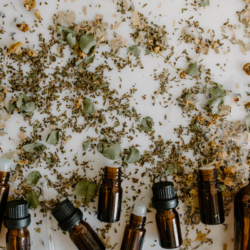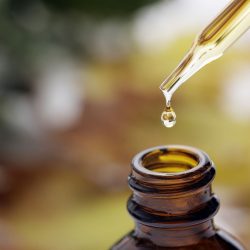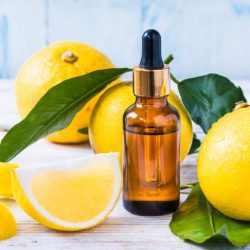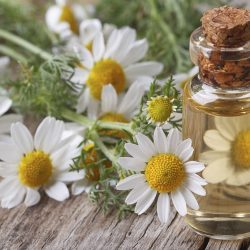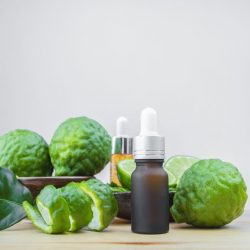Humidifier or dry diffuser? How to choose your organic essential oil diffuser according to its technical characteristics. In an air-conditioned office, bedroom or new home, opt for diffusers with an ultrasound humidifier. Their light, cool mist compensates for overly dry air. You’ll breathe easier, your skin won’t tug any more… and the diffusion can last a long time, as 4 drops of pure (and preferably organic) essential oil are enough to give off a fragrance. You’ll prefer the dry diffuser (by nebulisation) if you want to purify the air more effectively, or if your home is fairly damp. Their timer allows you to control the diffusion time. Either by alternating one minute of diffusion and one minute of stop, or by limiting its operation. We recommend no more than 15 minutes of diffusion two or three times a day.
Electric diffusers for organic essential oils fall into several categories: gentle heat, ventilation, ultra-sound, micro-diffusion and misting. To help you choose the diffuser that best suits your needs and budget, we’ll briefly explain the different models and their performance.
Background on diffusion
Atmospheric diffusion of essential oils is a complementary method to medical treatment, enriching the atmosphere while offering therapeutic benefits. For safe, effective use, we recommend diffusing for around 10 minutes every hour, avoiding practices that are unsuitable for certain populations, such as children under the age of three. Dry or wet inhalation techniques should be chosen according to the age and medical condition of the user. It is crucial to select the type of diffuser carefully and avoid irritating essential oils. This careful approach maximises the benefits of essential oils, improving air quality and contributing to emotional and physical well-being.
What does diffusion involve?
Atmospheric diffusion of essential oils complements medical care and requires careful application to be effective and safe. For a pleasant olfactory atmosphere, programme the diffusion for about 10 minutes every hour. Avoid dry inhalation, which involves applying essential oils to a handkerchief, for children under the age of three, epileptics and asthmatics. Wet inhalation is preferable, with a mixture of 3 to 8 drops of essential oil in an inhaler bowl, suitable for adults and children over the age of 12, for sessions of 3 to 7 minutes, repeated two or three times a day.
Do not diffuse essential oils in the bedroom of a sleeping child, and allow pets to leave the room during diffusion. Avoid irritating essential oils such as thymol, carvacrol and eugenol. These measures guarantee a safe and beneficial atmospheric diffusion, creating a pleasant atmosphere and promoting well-being, especially in the presence of young children or people with specific medical conditions.
Selecting the right diffuser is crucial for optimal diffusion. Various types of diffuser exist, each with its own characteristics and diffusion techniques, affecting their operation, use, cost and aesthetics. Diffusing essential oils can improve health, notably by purifying the air, acting on the respiratory and nervous systems, and influencing mood and emotional balance through olfactotherapy.
To get the most out of essential oils diffused, choose your diffuser and oils carefully, while complying with safety instructions and the specific needs of users.
What are the rules to follow?
The ambient diffusion of essential oils can be safe and beneficial, provided certain basic rules are followed. It’s important to recognise that essential oils are active substances, requiring careful, measured use. Here are some tips for safe diffusion:
- Make sure the room is well ventilated by airing daily, to prevent excessive concentrations of essential oils.
- Respect the recommended doses, as these oils are highly concentrated in active ingredients. A few drops are enough for optimum effectiveness.
- Switch off the diffuser before going to bed, or opt for a programmable device to allow alternating diffusion with cycles and pauses.
- Limit the diffusion time to 15 minutes per hour, and do not exceed 3 to 4 sessions per day. Oils diluted in water can be diffused for up to 30 minutes.
However, the use of essential oils requires particular attention in the following cases:
- Pregnant or breast-feeding women: the active ingredients in the oils may affect the baby.
- Children under the age of 7: some oils may be unsuitable.
- People with epilepsy, asthma, allergies or neurological disorders.
- Animals, especially cats, which are very sensitive to essential oils.
By observing these precautions, you can make essential oil diffusion a pleasant and beneficial part of your daily routine, creating a healthy and soothing atmosphere in your home.
What is olfactotherapy?
Organic Essential Oil Diffusers by Soft Heat
These essential oil diffusers are very easy to use and also make it possible to enjoy the benefits of diffusing essential oils at an affordable cost. This type of diffuser is also very easy to maintain, so you can change the oil regularly.
The heat diffuser is considered one of the easiest to use for diffusing essential oils. This category includes a variety of options, from a dish placed on a radiator to models equipped with a thermostat, via the traditional candle perfume burner. These diffusers use controlled heat to avoid altering the beneficial properties of the essential oils, which retain their virtues as long as the temperature does not exceed 45°C. However, for greater safety, we recommend that you choose devices that do not heat above 40°C.
Soft-heat diffusers use an electric resistance to gently heat the essential oils, ensuring effective diffusion while preserving their qualities. These diffusers are particularly suitable for small spaces, no larger than 20 square metres, and offer the advantage of being very quiet. This method allows pleasant, safe diffusion of essential oils in small environments.
Essential Oil Diffusers by Ventilation
The principle is very simple: a fan “propels” air through a pad that you have previously soaked in essential oils. This pulsating air current instantly spreads the essential oils around the room. It’s very quiet, so you can use it in a bedroom or office. It’s not powerful enough to cover an entire home.
The air is diffused cold, which preserves all the benefits of the essential oils. The blast of air produced by the fan propels the micro-particles of oil into the air, passing through the area where they are deposited.
This essential oil diffuser allows you to change the scent of the diffused oil regularly, thanks to its ease of maintenance. This method of diffusion is extremely fast and effective, providing optimum diffusion in spaces of up to 60m².
Fan diffusers work by using a fan that is placed next to a blotter soaked in essential oil. The air movement generated by the fan encourages the oil to evaporate. Despite the fact that this type of diffuser evaporates oils quickly, it is still useful for creating a fragrant atmosphere indoors. Its simple, direct method diffuses the aroma of essential oils, even if it doesn’t offer the best efficiency for exploiting all their therapeutic properties.
Ultrasound or misting essential oil diffusers
The frequency of an ultrasound is higher than 20khz and cannot be heard by the human ear (too high-pitched). A membrane vibrates in the frequency range between 20 kHz and 80 kHz. Droplets are torn from the surface of the liquid. As a result, the water is “atomised” into droplets so fine that they evaporate into mist. The size of the droplets depends on the frequency of the device. The higher the frequency, the finer the droplets and the characteristics of the fluid (density, viscosity, surface tension).
This is a cold diffusion method that does not alter the original fragrance of the essential oils. It also preserves their energetic values. The ultrasound produced by the diffuser transforms the mixture of water and oils into a light mist that spreads through the air.
This method of diffusion also slightly humidifies the ambient air, making it less dry and more breathable. It also helps to oxygenate the blood. This diffuser is suitable for medium-sized rooms, but will prove very useful for breathing better air. Air is generally dried out by our heating systems.
Mist essential oil diffuser
These hybrid devices diffuse both essential oils and water vapour (which will humidify your atmosphere if it’s a little too dry).
These essential oil diffusers create a light mist from the water in its reservoir. The essential oils are added to the water in small proportions. The mist containing the essential oil fragrances is then diffused into the air. The mister also makes the ambient air less dry, while ensuring that the essential oils are diffused.
Our diffusers have built-in water level detectors, which stop automatically if the water level becomes too low. What’s more, most of them are fitted with LED lights, offering a range of colours and making the misters very aesthetically pleasing.
Foggers are one of the most popular diffusers, frequently available in pharmacies or organic shops. Fitted with an ultrasound probe, they produce a light mist that disperses essential oils diluted in water. This gentle, subtle process is ideal for delicately perfuming the room, and is particularly suitable for people sensitive to strong odours.
Mist diffuser
Nebulisation diffusion uses vibrations to separate and diffuse the essential oil molecules in the form of very fine particles emitted into the ambient air. This method of diffusion is carried out cold and therefore preserves all the therapeutic properties of the essential oils.
Most diffusers consist of a motorised base and a glass section. This is where the essential oils are stored. Nebulisers are very effective and can diffuse oils in spaces of up to 120m². Fitted with a power variator.
A nebuliser is an electrical device designed to diffuse essential oils in the form of micro-droplets into the air. Working cold, this type of diffuser preserves the integrity of the essential oils without heating them. The pure oils are introduced into a glass container. These diffusers are often attractive because of their elegant design and their effectiveness, diffusing the oils purely. This distinguishes them from mist diffusers, which require the oils to be diluted in water.
The micro-particles diffused by the nebuliser penetrate deep into the lungs, maximising the therapeutic benefits of the essential oils. This type of diffusion is therefore particularly recommended for therapeutic use of essential oils. However, nebulisers have certain disadvantages, notably their higher cost and their fragility due to the glass composition of the device. What’s more, they can be relatively noisy when in operation, which can be a disadvantage for some users.
Nomad essential oil diffuser
This is a natural type of diffuser that doesn’t need electricity to work. Nomadic diffusers are suitable for small rooms such as bathrooms or toilets, or even cars.
To enjoy the benefits of essential oils, we recommend investing in a diffuser that does not use a lot of heat (which oxidises the essential oils) and does not use water (water prevents the essential oils from ionising).
It is perfectly possible to diffuse essential oils without using a specialised diffuser. Although this method is generally less effective in terms of range, it remains a simple and affordable option. To diffuse essential oils, place a few drops on a cotton wool pad near a fan. You can also mix them with distilled water in a spray bottle. You can also apply a few drops to a tissue that you keep close by. These simple methods make it easier to enjoy their benefits.
Explore other ways of benefiting from essential oils: inhale them directly from the bottle, apply them to your skin, particularly the hollows of your wrists, or incorporate them into your massages and treatments. Choose the method that best suits your needs.
When choosing a diffuser, take several criteria into account: the quality of the oils, the space to be perfumed, aesthetics, noise, cost, quality and maintenance. Once you’ve found the ideal diffuser, select the essential oils that best match your expectations and plans.


